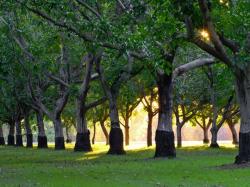Walnut Farmers Support Continuation Of California Walnut Board
March 19, 2014 | 4 min to read

California walnut producers will be asked later this month to vote in a referendum to decide whether or not the programs of the California Walnut Board will continue for another five years. Ballots will be mailed to all California walnut producers March 29 and they must be returned via mail with a postmark not later than April 19.
The California Walnut Board is a federal marketing program operating with oversight from the United States Department of Food and Agriculture. The program works in conjunction with a separate, but cooperating, entity called the California Walnut Commission. For operating efficiencies the two programs are implemented by the same staff based in Folsom, CA.
Much more information about these programs is available on the web at www.walnuts.org. In short, the California Walnut Board (CWB) conducts activities in the following areas: production research, food safety, grades & standards, regulatory matters and U.S. marketing activities. Meanwhile the California Walnut Commission (CWC) is charged with: health and nutrition research, export market development, educating government officials and communicating with industry members.
The USDA requires growers, who fund marketing order programs like the CWB through mandatory assessment, vote to decide if they want to continue with the programs every five years. Several members of the California walnut industry are speaking out about the good work of this program and urging walnut farmers to vote in favor of continuing the program. These growers attribute the CWB with much of the industry’s success and note that California is currently experiencing an all-time high price per pound AND an all-time high crop size.
“In my opinion, all growers in California have benefited directly from research funded by the California Walnut Board,” said Todd Ramos, who farms 640 acres of walnuts in Yolo and Solano counties. “In recent years walnut growers have seen average yield per acre increase, quality of our product improve, increasing tonnage and record high prices. This is a direct result of the research funding and market development provided by the California Walnut Board.”
Ramos explained that an observable benefit from this funding and research is the release of California’s three most planted varieties, Chandler, Tulare and Howard and that the walnut breeding program is currently evaluating over 70 unreleased varieties which will lead to additional releases in the future. The financial support and direction provide by CWB has led to the development of disease resistant rootstocks such as VX211, Vlach and RX1. To ensure the walnut improvement program continues to be a priority for researchers, the CWB has set up an endowment of $2 million at University of California, Davis.
Ramos further noted that with respect to daily farming practices by all growers in California, the CWB has supported research on blight control, ethrel use, control of husk fly and codling moth along with spider mite management and pheromone puffers. The CWB Research Committee has also subsidized research on pruning, crown gall, water management, soil fumigation and planting density.
Pat Mecklenberg of Derby Orchards in Rio Oso shares Ramos’ support of the CWB.
“As a business owner, I cannot think of a better investment than investing in our own industry,” she said. “Looking at the increased market demand for walnuts for the past ten years and all that the California Walnut Board has done to promote California walnuts, it’s clear to me this program has given us a better return on investment than any other place I have invested money.”
Pete Jelavich, a walnut farmer in Sutter and Yuba counties, also voiced his support of the CWB. “CWB provides many benefits to walnut farmers including: being proactive in providing information and implementation of food safety programs for industry members; monitoring and inspections of outbound product to buyers and consumers; providing research for insect and disease control, propagation of new varieties, as well as pursuing the use of safer, better, and more effective controls to get product from the farm to the consumer and promoting the many health benefits that have been published through the efforts of the California Walnut Commission. I strongly support the vote to continue the operations of the California Walnut Board.”
“The programs of the Walnut Marketing Board are really effective and they are an integral part of the industry’s great success, especially over the last few years,” said Jonathan W. Field, manager of the Walnut Bargaining Association, a group which supports the efforts of the CWB. Field cited the exceptional production and marketing data developed through the CWB as critical in helping growers make planting decisions; handlers find new markets; banks to make financial decisions and for his organization, the Walnut Bargaining Association, to establish fair grower prices and maintain good returns for growers and handlers. “The historical data available could be lost if the marketing order is not continued.”
Field also noted that CWB provides a forum for discussion of issues that impact the growing and marketing of California walnuts such as: food safety; pests and disease pressure; improved production practices; product theft; drought, etc.
“No other forum is available specific to walnuts that has the credibility of the CWB,” he said.
Donald Norene, who also farms walnuts in Rio Oso, summed it up and reminded walnut farmers of the importance of the upcoming referendum.
“This spring we walnut growers have an important decision to make on behalf of our industry,” said Norene. “The continuation of the California walnut marketing order is dependent on the outcome of the vote. Growers should consider the numerous benefits – crop production research, new variety research, methyl bromide replacement research, food safety efforts, domestic market promotion and the viability of the entire industry – we receive for the small cost of the California Walnut Board’s assessments.”
Source: Walnut Bargaining Association
